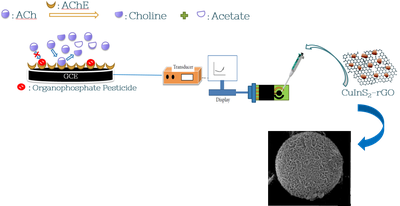Kasetsart University, Department of Chemistry, Bangkok, Thailand
Electrochemical biosensor for pesticide detection
Organophosphorus pesticides (OPs) are widely used as the insecticides and nerve agents throughout the world (approximately 36%) due to their broad-spectrum and high-efficient properties to kill/control the pests/insects, since the Second World War. For most pesticides, enzyme-based electroanalytical technique is one of the most promising methods, offering many advantages such as fast response, quick fabrication, good sensitivity, high selectivity, easy operation, low cost, and portability when compared to other analytical techniques.
Herein, we are synthesizing and studying spongelike CuInS2 microphere-graphene composite for its possibility for use as enzyme-based pesticide biosensor to determine hazardous pesticide, which is of great interest to the researchers in terms of their less agglomeration nature, excellent charge transportation, high specific surface area, good conductivity, and interconnected porous channels, which may exhibit promising applications in pesticide biosensors.


